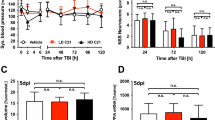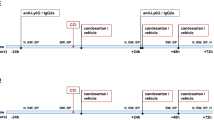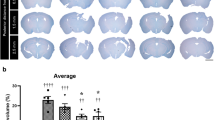Abstract
Traumatic brain injury (TBI) results in complex pathological reactions, the initial lesion worsened by secondary inflammation and edema. Angiotensin II (Ang II) is produced in the brain and Ang II receptor type 1 (AT1R) overstimulation produces vasoconstriction and inflammation. Ang II receptor blockers (ARBs) are neuroprotective in models of stroke but little is known of their effect when administered in TBI models. We therefore performed controlled cortical impact (CCI) injury on mice to investigate whether the ARB candesartan would mitigate any effects of TBI. We administered candesartan or vehicle to mice 5 h before CCI injury. Candesartan treatment reduced the lesion volume after CCI injury by approximately 50%, decreased the number of dying neurons, lessened the number of activated microglial cells, protected cerebral blood flow (CBF), and reduced the expression of the cytokine TGFβ1 while increasing expression of TGFβ3. Candesartan-treated mice also showed better motor skills on the rotarod 3 days after injury, and improved performance in the Morris water maze 4 weeks after injury. These results indicate that candesartan is neuroprotective, reducing neuronal injury, decreasing lesion volume and microglial activation, protecting CBF and improving functional behavior in a mouse model of TBI. Co-treatment with a peroxisome proliferator-activated receptor-gamma (PPARγ) antagonist significantly reduced some of the beneficial effects of candesartan after CCI, suggesting that PPARγ activation may contribute to part or to all of the neuroprotective effect of candesartan. Overall, our data suggest that ARBs with dual AT1R-blocking and PPARγ activation properties may have therapeutic value in treating TBI.
Similar content being viewed by others
Log in or create a free account to read this content
Gain free access to this article, as well as selected content from this journal and more on nature.com
or
References
An J, Nakajima T, Kuba K, Kimura A (2010). Losartan inhibits LPS-induced inflammatory signaling through a PPARgamma-dependent mechanism in human THP-1 macrophages. Hypertens Res Off J Jap Soc Hypertens 33: 831–835.
Ando H, Jezova M, Zhou J, Saavedra JM (2004a). Angiotensin II AT1 receptor blockade decreases brain artery inflammation in a stress-prone rat strain. Ann N Y Acad Sci 1018: 345–350.
Ando H, Zhou J, Macova M, Imboden H, Saavedra JM (2004b). Angiotensin II AT1 receptor blockade reverses pathological hypertrophy and inflammation in brain microvessels of spontaneously hypertensive rats. Stroke 35: 1726–1731.
Ariza M, Matarin MD, Junque C, Mataro M, Clemente I, Moral P et al (2006). Influence of Angiotensin-converting enzyme polymorphism on neuropsychological subacute performance in moderate and severe traumatic brain injury. J Neuropsychiatry Clin Neurosci 18: 39–44.
Awad AS (2011). Effect of combined treatment with curcumin and candesartan on ischemic brain damage in mice. J Stroke Cerebrovasc Dis 20: 541–548.
Baranov D, Armstead WM (2003). Selective blockade of AT1 receptor attenuates impairment of hypotensive autoregulation and improves cerebral blood flow after brain injury in the newborn pig. Anesthesiology 99: 1118–1124.
Barkhoudarian G, Hovda DA, Giza CC (2011). The molecular pathophysiology of concussive brain injury. Clin Sports Med 30: 33–48 vii-iii.
Benicky J, Sanchez-Lemus E, Honda M, Pang T, Orecna M, Wang J et al (2011). Angiotensin II AT(1) receptor blockade ameliorates brain inflammation. Neuropsychopharmacology 36: 857–870.
Benigni A, Cassis P, Remuzzi G (2010). Angiotensin II revisited: new roles in inflammation, immunology and aging. EMBO Mol Med 2: 247–257.
Benson SC, Pershadsingh HA, Ho CI, Chittiboyina A, Desai P, Pravenec M et al (2004). Identification of telmisartan as a unique angiotensin II receptor antagonist with selective PPARgamma-modulating activity. Hypertension 43: 993–1002.
Bernardo A, Minghetti L (2006). PPAR-gamma agonists as regulators of microglial activation and brain inflammation. Curr Pharm Des 12: 93–109.
Burson JM, Aguilera G, Gross KW, Sigmund CD (1994). Differential expression of angiotensin receptor 1A and 1B in mouse. Am J Physiol 267: E260–267.
Chodobski A, Chung I, Kozniewska E, Ivanenko T, Chang W, Harrington JF et al (2003). Early neutrophilic expression of vascular endothelial growth factor after traumatic brain injury. Neuroscience 122: 853–867.
Davies NM, Kehoe PG, Ben-Shlomo Y, Martin RM (2011). Associations of anti-hypertensive treatments with Alzheimer's disease, vascular dementia, and other dementias. J Alzheimers Dis 26: 699–708.
Davisson RL, Oliverio MI, Coffman TM, Sigmund CD (2000). Divergent functions of angiotensin II receptor isoforms in the brain. J Clin Invest 106: 103–106.
Engelhorn T, Goerike S, Doerfler A, Okorn C, Forsting M, Heusch G et al (2004). The angiotensin II type 1-receptor blocker candesartan increases cerebral blood flow, reduces infarct size, and improves neurologic outcome after transient cerebral ischemia in rats. J Cereb Blood Flow Metab 24: 467–474.
Erbe DV, Gartrell K, Zhang YL, Suri V, Kirincich SJ, Will S et al (2006). Molecular activation of PPARgamma by angiotensin II type 1-receptor antagonists. Vascul Pharmacol 45: 154–162.
Fogari R, Zoppi A (2004). Effect of antihypertensive agents on quality of life in the elderly. Drugs Aging 21: 377–393.
Gillespie W, Tyagi N, Tyagi SC (2011). Role of PPARgamma, a nuclear hormone receptor in neuroprotection. Indian J Biochem Biophys 48: 73–81.
Guan W, Kozak A, El-Remessy AB, Johnson MH, Pillai BA, Fagan SC (2011). Acute Treatment with Candesartan Reduces Early Injury After Permanent Middle Cerebral Artery Occlusion. Transl Stroke Res 2: 179–185.
Hamm RJ (2001). Neurobehavioral assessment of outcome following traumatic brain injury in rats: an evaluation of selected measures. J Neurotrauma 18: 1207–1216.
Hansson L, Lithell H, Skoog I, Baro F, Banki CM, Breteler M et al (1999). Study on COgnition and Prognosis in the Elderly (SCOPE). Blood Press 8: 177–183.
Harasawa S, Otsuka Y, Okubo K, Koike M, Fujita H, Kushiro T et al (2010). Amlodipine suppressed cardiac gene expression of brain natriuretic peptide, transforming growth factor-beta and fibronectin mediated by aldosterone in male stroke-prone spontaneously hypertensive rats. J Pharm Pharmacol 62: 1740–1745.
Igase M, Kohara K, Miki T (2012). The Association between Hypertension and Dementia in the Elderly. Int J Hypertens 2012: 320648.
Ito T, Nishimura Y, Saavedra J (2001). Pre-treatment with candesartan protects from cerebral ischaemia. J Renin Angiotensin Aldosterone Syst 2: 174–179.
Ito T, Yamakawa H, Bregonzio C, Terron JA, Falcon-Neri A, Saavedra JM (2002). Protection against ischemia and improvement of cerebral blood flow in genetically hypertensive rats by chronic pretreatment with an angiotensin II AT1 antagonist. Stroke 33: 2297–2303.
Ji Y, Liu J, Wang Z, Liu N, Gou W (2009). PPARgamma agonist, rosiglitazone, regulates angiotensin II-induced vascular inflammation through the TLR4-dependent signaling pathway. Lab Invest J Tech Methods Pathol 89: 887–902.
Jiao B, Wang YS, Cheng YN, Gao JJ, Zhang QZ (2011). Valsartan attenuated oxidative stress, decreased MCP-1 and TGF-beta1 expression in glomerular mesangial and epithelial cells induced by high-glucose levels. Biosci Trends 5: 173–181.
Johren O, Saavedra JM (1996). Expression of AT1A and AT1B angiotensin II receptor messenger RNA in forebrain of 2-wk-old rats. Am J Physiol 271: E104–112.
Jung KH, Chu K, Lee ST, Kim SJ, Song EC, Kim EH et al (2007). Blockade of AT1 receptor reduces apoptosis, inflammation, and oxidative stress in normotensive rats with intracerebral hemorrhage. J Pharmacol Exp Ther 322: 1051–1058.
Kasahara Y, Taguchi A, Uno H, Nakano A, Nakagomi T, Hirose H et al (2010). Telmisartan suppresses cerebral injury in a murine model of transient focal ischemia. Brain Res 1340: 70–80.
Lanz TV, Ding Z, Ho PP, Lou J, Agrawal AN, Srinagesh H et al (2010). Angiotensin II sustains brain inflammation in mice via TGF-β. J Clin Invest 120: 2782–2794.
Larrayoz IM, Pang T, Benicky J, Pavel J, Sanchez-Lemus E, Saavedra JM (2009). Candesartan reduces the innate immune response to lipopolysaccharide in human monocytes. J Hypertens 27: 2365–2376.
Li JM, Mogi M, Iwanami J, Min LJ, Tsukuda K, Sakata A et al (2008). Temporary pretreatment with the angiotensin II type 1 receptor blocker, valsartan, prevents ischemic brain damage through an increase in capillary density. Stroke 39: 2029–2036.
Liu H, Kitazato KT, Uno M, Yagi K, Kanematsu Y, Tamura T et al (2008). Protective mechanisms of the angiotensin II type 1 receptor blocker candesartan against cerebral ischemia: in-vivo and in-vitro studies. J Hypertens 26: 1435–1445.
Loane DJ, Faden AI (2010). Neuroprotection for traumatic brain injury: translational challenges and emerging therapeutic strategies. Trends Pharmacol Sci 31: 596–604.
Maeda A, Okazaki T, Inoue M, Kitazono T, Yamasaki M, Lemonnier FA et al (2009). Immunosuppressive effect of angiotensin receptor blocker on stimulation of mice CTLs by angiotensin II. Int Immunopharmacol 9: 1183–1188.
Malchiodi-Albedi F, Matteucci A, Bernardo A, Minghetti L (2008). PPAR-gamma, microglial cells, and ocular inflammation: new venues for potential therapeutic approaches. PPAR Res 2008: 295784.
Marklund N, Hillered L (2011). Animal modelling of traumatic brain injury in preclinical drug development: where do we go from here? Br J Pharmacol 164: 1207–1229.
McTigue DM, Tripathi R, Wei P, Lash AT (2007). The PPAR gamma agonist pioglitazone improves anatomical and locomotor recovery after rodent spinal cord injury. Experimental neurology 205: 396–406.
Meredith PA, Murray LS, McMurray JJ (2004). A putative placebo comparison of the SCOPE and LIFE trials. J Renin Angiotensin Aldosterone Syst 5: 59–63.
Nishimura Y, Ito T, Hoe K, Saavedra JM (2000). Chronic peripheral administration of the angiotensin II AT(1) receptor antagonist candesartan blocks brain AT(1) receptors. Brain Res 871: 29–38.
O'Connor WT, Smyth A, Gilchrist MD (2011). Animal models of traumatic brain injury: a critical evaluation. Pharmacol Ther 130: 106–113.
Occleston NL, Laverty HG, O'Kane S, Ferguson MW (2008). Prevention and reduction of scarring in the skin by transforming growth factor beta 3 (TGFbeta3): from laboratory discovery to clinical pharmaceutical. J Biomater Sci Polym Ed 19: 1047–1063.
Omura-Matsuoka E, Yagita Y, Sasaki T, Terasaki Y, Oyama N, Sugiyama Y et al (2009). Postischemic administration of angiotensin II type 1 receptor blocker reduces cerebral infarction size in hypertensive rats. Hypertens Res 32: 548–553.
Ozacmak VH, Sayan H, Cetin A, Akyildiz-Igdem A (2007). AT1 receptor blocker candesartan-induced attenuation of brain injury of rats subjected to chronic cerebral hypoperfusion. Neurochem Res 32: 1314–1321.
Pang T, Benicky J, Wang J, Orecna M, Sanchez-Lemus E, Saavedra JM (2012). Telmisartan ameliorates lipopolysaccharide-induced innate immune response through peroxisome proliferator-activated receptor-gamma activation in human monocytes. J Hypertens 30: 87–96.
Paul M, Poyan Mehr A, Kreutz R (2006). Physiology of local renin-angiotensin systems. Physiol Rev 86: 747–803.
Poon IO (2008). Effects of antihypertensive drug treatment on the risk of dementia and cognitive impairment. Pharmacotherapy 28: 366–375.
Ricote M, Li AC, Willson TM, Kelly CJ, Glass CK (1998). The peroxisome proliferator-activated receptor-gamma is a negative regulator of macrophage activation. Nature 391: 79–82.
Robbins ME, Zhao W, Garcia-Espinosa MA, Diz DI (2010). Renin-angiotensin system blockers and modulation of radiation-induced brain injury. Curr Drug Targets 11: 1413–1422.
Rodriguez-Pallares J, Rey P, Parga JA, Munoz A, Guerra MJ, Labandeira-Garcia JL (2008). Brain angiotensin enhances dopaminergic cell death via microglial activation and NADPH-derived ROS. Neurobiol Dis 31: 58–73.
Rosenkranz S (2004). TGF-beta1 and angiotensin networking in cardiac remodeling. Cardiovasc Res 63: 423–432.
Rotman N, Wahli W (2010). PPAR modulation of kinase-linked receptor signaling in physiology and disease. Physiology (Bethesda) 25: 176–185.
Saavedra JM (1992). Brain and pituitary angiotensin. Endocr Rev 13: 329–380.
Saavedra JM, Sanchez-Lemus E, Benicky J (2011). Blockade of brain angiotensin II AT1 receptors ameliorates stress, anxiety, brain inflammation and ischemia: therapeutic implications. Psychoneuroendocrinology 36: 1–18.
Santos CC, Zhang H, Liu M, Slutsky AS (2005). Bench-to-bedside review: biotrauma and modulation of the innate immune response. Crit Care 9: 280–286.
Savoia C, Schiffrin EL (2007). Vascular inflammation in hypertension and diabetes: molecular mechanisms and therapeutic interventions. Clin Sci (Lond) 112: 375–384.
Sookplung P, Siriussawakul A, Malakouti A, Sharma D, Wang J, Souter MJ et al (2011). Vasopressor use and effect on blood pressure after severe adult traumatic brain injury. Neurocrit Care 15: 46–54.
Stenman E, Edvinsson L (2004). Cerebral ischemia enhances vascular angiotensin AT1 receptor-mediated contraction in rats. Stroke 35: 970–974.
Sugawara A, Uruno A, Matsuda K, Funato T, Saito-Hakoda A, Kudo M et al (2011). Effects of PPARgamma agonists against vascular and renal dysfunction. Curr Mol Pharmacol.
Sugawara T, Kinouchi H, Oda M, Shoji H, Omae T, Mizoi K (2005). Candesartan reduces superoxide production after global cerebral ischemia. Neuroreport 16: 325–328.
Sun Y, Zhang JQ, Zhang J, Ramires FJ (1998). Angiotensin II, transforming growth factor-beta1 and repair in the infarcted heart. J Mol Cell Cardiol 30: 1559–1569.
Susarla BT, Laing ED, Yu P, Katagiri Y, Geller HM, Symes AJ (2011). Smad proteins differentially regulate transforming growth factor-β mediated induction of chondrotin sulfate proteoglycans. J Neurochem 119: 868–878.
Tham DM, Martin-McNulty B, Wang YX, Wilson DW, Vergona R, Sullivan ME et al (2002). Angiotensin II is associated with activation of NF-kappaB-mediated genes and downregulation of PPARs. Physiol Genomics 11: 21–30.
Thone-Reineke C, Steckelings UM, Unger T (2006). Angiotensin receptor blockers and cerebral protection in stroke. J Hypertens Suppl 24: S115–121.
Timaru-Kast R, Wyschkon S, Luh C, Schaible EV, Lehmann F, Merk P et al (2012). Delayed inhibition of angiotensin II receptor type 1 reduces secondary brain damage and improves functional recovery after experimental brain trauma*. Crit Care Med 40: 935–944.
Tsutsumi K, Saavedra JM (1991). Characterization and development of angiotensin II receptor subtypes (AT1 and AT2) in rat brain. Am J Physiol 261: R209–216.
Van Mieghem W, Billiouw JM, Brohet C, Dupont AG, Gazagnes MD, Heller F et al (2010). Are ACE-inhibitors or ARB's still needed for cardiovascular prevention in high risk patients? Insights from profess and transcend. Acta Clin Belg 65: 107–114.
Villapol S, Fau S, Renolleau S, Biran V, Charriaut-Marlangue C, Baud O (2011). Melatonin promotes myelination by decreasing white matter inflammation after neonatal stroke. Pediatr Res 69: 51–55.
Vivien D, Ali C (2006). Transforming growth factor-beta signalling in brain disorders. Cytokine Growth Factor Rev 17: 121–128.
Wang Y, Moges H, Bharucha Y, Symes A (2007). Smad3 null mice display more rapid wound closure and reduced scar formation after a stab wound to the cerebral cortex. Exp Neurol 203: 168–184.
Xiao J, Leung JC, Chan LY, Tang SC, Lai KN (2009). Crosstalk between peroxisome proliferator-activated receptor-gamma and angiotensin II in renal tubular epithelial cells in IgA nephropathy. Clin Immunol 132: 266–276.
Yamakawa H, Jezova M, Ando H, Saavedra JM (2003). Normalization of endothelial and inducible nitric oxide synthase expression in brain microvessels of spontaneously hypertensive rats by angiotensin II AT1 receptor inhibition. J Cereb Blood Flow Metab 23: 371–380.
Yi JH, Park SW, Brooks N, Lang BT, Vemuganti R (2008). PPARgamma agonist rosiglitazone is neuroprotective after traumatic brain injury via anti-inflammatory and anti-oxidative mechanisms. Brain Res 1244: 164–172.
Yu CM, Tipoe GL, Wing-Hon Lai K, Lau CP (2001). Effects of combination of angiotensin-converting enzyme inhibitor and angiotensin receptor antagonist on inflammatory cellular infiltration and myocardial interstitial fibrosis after acute myocardial infarction. J Am Coll Cardiol 38: 1207–1215.
Zanchetti A, Elmfeldt D (2006). Findings and implications of the Study on COgnition and Prognosis in the Elderly (SCOPE) – a review. Blood Press 15: 71–79.
Zhao SM, Shen LH, Li HW, Wang L, Chen H, Wang YL et al (2008). Down-regulation of the expression of angiotensin II type 1 receptor in neonatal rat cardiac fibroblast by activation of PPARgamma signal pathway. Chin J Physiol 51: 357–362.
Zhou J, Ando H, Macova M, Dou J, Saavedra JM (2005). Angiotensin II AT1 receptor blockade abolishes brain microvascular inflammation and heat shock protein responses in hypertensive rats. J Cereb Blood Flow Metab 25: 878–886.
Zhou J, Pavel J, Macova M, Yu ZX, Imboden H, Ge L et al (2006). AT1 receptor blockade regulates the local angiotensin II system in cerebral microvessels from spontaneously hypertensive rats. Stroke 37: 1271–1276.
Zorad S, Dou JT, Benicky J, Hutanu D, Tybitanclova K, Zhou J et al (2006). Long-term angiotensin II AT1 receptor inhibition produces adipose tissue hypotrophy accompanied by increased expression of adiponectin and PPARgamma. Eur J Pharmacol 552: 112–122.
Zuhayra M, Zhao Y, von Forstner C, Henze E, Gohlke P, Culman J et al (2011). Activation of cerebral peroxisome proliferator-activated receptors gamma (PPARgamma) reduces neuronal damage in the substantia nigra after transient focal cerebral ischaemia in the rat. Neuropathol Appl Neurobiol 37: 738–752.
Acknowledgements
This study was supported by a pilot award from the Center for Neuroscience and Regenerative Medicine (CNRM) grant (AJS). SV is supported by a CNRM postdoctoral fellowship. JMS and ESL are supported by the Division of Intramural Research Programs, National Institute of Mental Health, National Institutes of Health. We thank Laura Tucker, Oz Malkesman, and Amanda Fu from the CNRM pre-clinical core facility for expert advice, Dr Tim ÓNeil for his assistance with blood pressure measurements. We are grateful to members of the Symes and Saavedra laboratories for their helpful comments and suggestions. The opinions and assertions contained herein are the private opinions of the authors and are not to be construed as reflecting the views of the Uniformed Services University of the Health Sciences or the US Department of Defense.
Author information
Authors and Affiliations
Corresponding author
Ethics declarations
Competing interests
The authors declare no conflict of interest.
Additional information
Supplementary Information accompanies the paper on the Neuropsychopharmacology website
Rights and permissions
About this article
Cite this article
Villapol, S., Yaszemski, A., Logan, T. et al. Candesartan, an Angiotensin II AT1-Receptor Blocker and PPAR-γ Agonist, Reduces Lesion Volume and Improves Motor and Memory Function After Traumatic Brain Injury in Mice. Neuropsychopharmacol 37, 2817–2829 (2012). https://doi.org/10.1038/npp.2012.152
Received:
Revised:
Accepted:
Published:
Issue date:
DOI: https://doi.org/10.1038/npp.2012.152
Keywords
This article is cited by
-
AT 1 inhibition mediated neuroprotection after experimental traumatic brain injury is dependent on neutrophils in male mice
Scientific Reports (2023)
-
The Renin Angiotensin System as a Therapeutic Target in Traumatic Brain Injury
Neurotherapeutics (2023)
-
Phosphodiesterase-5 (PDE-5) Inhibitors as Therapy for Cerebrovascular Dysfunction in Chronic Traumatic Brain Injury
Neurotherapeutics (2023)
-
AT2 activation does not influence brain damage in the early phase after experimental traumatic brain injury in male mice
Scientific Reports (2022)
-
Addressing Peroxisome Proliferator-Activated Receptor-gamma in 3-Nitropropionic Acid-Induced Striatal Neurotoxicity in Rats
Molecular Neurobiology (2022)



